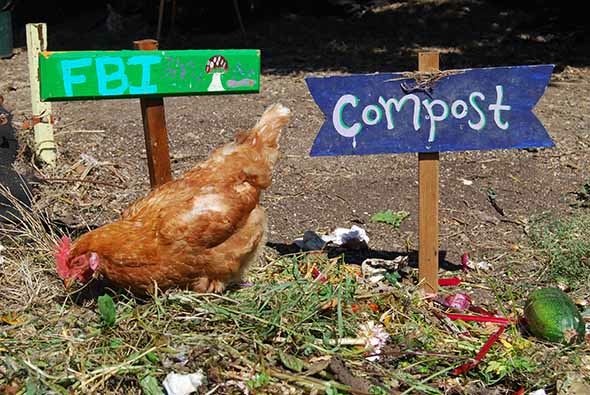Garden Science: Compost Lab

Summary
In this 6th grade Science class, students learn how to build a compost pile, learn about organisms needed for decomposition, and begin to understand the purpose of compost in the garden.
Objectives
After this lesson, students will be able to:
- Explain the different layers in a compost pile (browns, greens, food scraps, manure, water and air)
- Identify the essential organisms in a compost pile
- Explain the process of decomposition
- Explain the importance of compost
Assessments
During this lesson, students will:
- Discuss and label the necessary components of the compost pile using the Compost Cake visual aid (browns, greens, food scraps, manure, water and air)
- Discuss the essential organisms required for decomposition (fungus, bacteria, and invertebrates) and explain that each is critical to the speed of decomposition
- Identify and discuss compost at several different stages on Compost Row from food scraps to fertile soil
- Discuss that composting speeds up decomposition, reduces waste, and replenishes soil
Materials
- Compost pile or Compost Row (several piles of compost at different stages of decomposition)
- Compost Cake visual aid
- Compost Cake ingredient cards with Velcro backing
- File folder labeled “Top Secret” with images of the FBI inside
- Thermometer
- Bucket of sifted compost
Before You Begin
- Build a compost pile (Compost Row)
- Gather materials for your greens layer, browns layer, and food scraps into small piles near your compost, as examples of the different ingredients
- Insert a thermometer into the hot pile
- Create the Compost Cake visual aid
- Create the Compost Cake ingredient cards
- Create the FBI images and their “Top Secret” folder
Procedures
At the Opening Circle
- Welcome students and introduce the compost lab. Invite them to share what they think they know about compost.
- By a show of raised hands, ask students: “who has heard of decomposition?” Ask for a volunteer to define the term.
- Explain there are three main categories of organisms responsible for decomposition and that we use the acronym FBI to remember who they are: fungus, bacteria, and invertebrates.
- Prompt students to think about why we might build compost piles in the garden when decomposition is occurring all around us all the time. Explain to students that composting speeds up decomposition, reduces waste, and replenishes soil.
- Ask students to be prepared to share either one thing they learned during the compost lab, or a question they have about compost when they return for Closing Circle.
- Divide students into working groups. In your small group, ask students to share one question they have about compost before participating in the lab.
At the Compost Station
- Review with students what decomposition means, and what decomposers are (FBI).
- Explain that Decomposers, like all living organisms, have three main needs for survival; food, water, air. When building our compost piles, we are creating an environment suitable for the FBI by providing food, water, and air.
- Show students the Compost Cake visual aid and explain that building a compost pile is similar to building a layer cake.
- Show students the Compost Cake ingredient cards, and invite them to identify each one as they arrange the cards on the visual aid: C is for Carbon (sticks, woodchips, hay, straw, “the browns”), N is for Nitrogen (living plant matter like leaves and grasses, “the greens”), M is for Manure (horse, duck, chicken manure, which are rich in microorganisms), N is for Nitrogen (this time from food scraps).
- Open the “Top Secret” file folder and have students identify the FBI while looking at images of each.
- Explain that each ingredient provides food, air, or water for the FBI.
- Direct students’ attention to the thermometer in the compost pile. Take guesses from students on how hot the compost pile gets and why it heats up. Have students read the thermometer and explain that decomposition is happening fastest when the compost is at the ideal temperature of 130-160 degrees Fahrenheit.
- Take guesses for what causes the heat. Draw an analogy between a middle school dance with a hundred students moving around in one room, and the FBI in the compost pile. Individually, we hardly notice our own body heat, but when we are all together eating, digesting, and moving around, our heat is noticeable and the room heats up. Explain that the billions of active bacteria give off heat while they decompose the pile.
- Show students the progression of the compost piles from start to finish with a walk down Compost Row.
- After showing all the stages of decomposition, demonstrate the sifting process. Take a handful of soil and explain that there are billions of bacteria in each handful.
- Invite students to hold finished compost in their own hands. Explain that the components of this pile have been decomposed and changed into living soil.
- Ask students to identify what happens to crops before and after being composted (they are eaten as food, with the remaining scraps composted, and after the composting process are used to nourish other plants that are on their way to becoming food). Point out that that the same nutrients are recycled through this process to feed humans and other animals, the FBI, and plants.
At the Closing Circle
Remind students to think about one thing they learned about compost or a question they have about compost. Facilitate a Think Pair Share discussing either one thing they learned or a question they have about compost.
Vocabulary
Fungus
Bacteria
Invertebrate